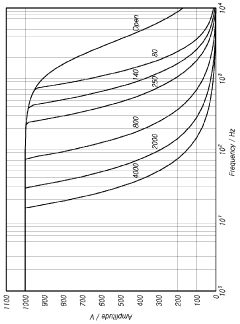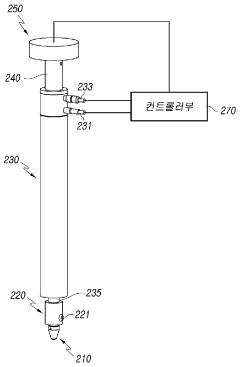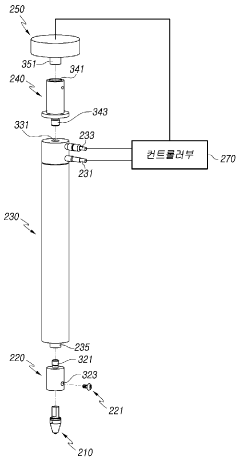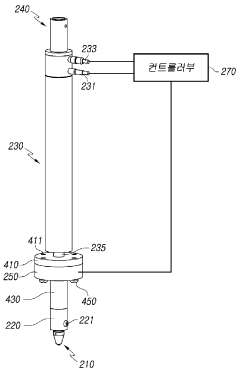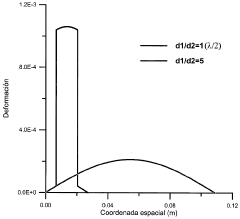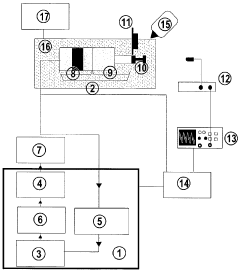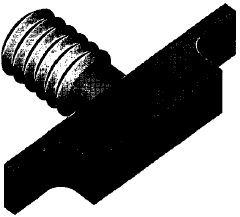Assessing Material Fatigue with Piezoelectric Sensors
JUL 17, 20259 MIN READ
Generate Your Research Report Instantly with AI Agent
Patsnap Eureka helps you evaluate technical feasibility & market potential.
Piezoelectric Sensing for Fatigue Assessment: Background and Objectives
Material fatigue is a critical concern in various engineering fields, affecting the safety, reliability, and longevity of structures and components. The assessment of material fatigue has traditionally relied on time-consuming and often destructive testing methods. However, the advent of piezoelectric sensing technology has opened new avenues for non-destructive, real-time fatigue assessment, revolutionizing the field of structural health monitoring.
Piezoelectric sensors, which convert mechanical stress into electrical signals and vice versa, have emerged as a promising solution for detecting and monitoring material fatigue. These sensors can be integrated into structures or attached to their surfaces, providing continuous data on the material's response to stress and strain. The technology's ability to detect minute changes in material properties makes it particularly suitable for early detection of fatigue-induced damage.
The evolution of piezoelectric sensing for fatigue assessment can be traced back to the mid-20th century, with significant advancements in recent decades. Initial applications were limited due to technological constraints, but improvements in sensor design, signal processing, and data analysis techniques have greatly expanded their capabilities. Today, piezoelectric sensors are used across various industries, including aerospace, automotive, civil engineering, and energy production.
The primary objective of using piezoelectric sensors for fatigue assessment is to develop a reliable, cost-effective, and non-invasive method for monitoring the structural integrity of materials and components throughout their lifecycle. This technology aims to enable predictive maintenance strategies, reduce downtime, and enhance safety by providing real-time data on material health.
Key goals in the development of piezoelectric sensing for fatigue assessment include improving sensor sensitivity and durability, enhancing signal processing algorithms to filter out noise and environmental factors, and developing advanced data interpretation methods. There is also a focus on miniaturization and integration of sensors into smart materials and structures, allowing for more seamless and widespread implementation.
The potential impact of this technology extends beyond traditional engineering applications. As industries move towards more sustainable practices, the ability to accurately assess and extend the life of materials and structures becomes increasingly important. Piezoelectric sensing offers a pathway to optimize resource use, reduce waste, and improve the overall efficiency of engineered systems.
Looking ahead, the field of piezoelectric sensing for fatigue assessment is poised for further innovation. Research is ongoing to develop self-powered sensors, explore new piezoelectric materials with enhanced properties, and integrate artificial intelligence for more sophisticated data analysis and prediction models. These advancements promise to further refine the accuracy and applicability of fatigue assessment techniques across diverse engineering domains.
Piezoelectric sensors, which convert mechanical stress into electrical signals and vice versa, have emerged as a promising solution for detecting and monitoring material fatigue. These sensors can be integrated into structures or attached to their surfaces, providing continuous data on the material's response to stress and strain. The technology's ability to detect minute changes in material properties makes it particularly suitable for early detection of fatigue-induced damage.
The evolution of piezoelectric sensing for fatigue assessment can be traced back to the mid-20th century, with significant advancements in recent decades. Initial applications were limited due to technological constraints, but improvements in sensor design, signal processing, and data analysis techniques have greatly expanded their capabilities. Today, piezoelectric sensors are used across various industries, including aerospace, automotive, civil engineering, and energy production.
The primary objective of using piezoelectric sensors for fatigue assessment is to develop a reliable, cost-effective, and non-invasive method for monitoring the structural integrity of materials and components throughout their lifecycle. This technology aims to enable predictive maintenance strategies, reduce downtime, and enhance safety by providing real-time data on material health.
Key goals in the development of piezoelectric sensing for fatigue assessment include improving sensor sensitivity and durability, enhancing signal processing algorithms to filter out noise and environmental factors, and developing advanced data interpretation methods. There is also a focus on miniaturization and integration of sensors into smart materials and structures, allowing for more seamless and widespread implementation.
The potential impact of this technology extends beyond traditional engineering applications. As industries move towards more sustainable practices, the ability to accurately assess and extend the life of materials and structures becomes increasingly important. Piezoelectric sensing offers a pathway to optimize resource use, reduce waste, and improve the overall efficiency of engineered systems.
Looking ahead, the field of piezoelectric sensing for fatigue assessment is poised for further innovation. Research is ongoing to develop self-powered sensors, explore new piezoelectric materials with enhanced properties, and integrate artificial intelligence for more sophisticated data analysis and prediction models. These advancements promise to further refine the accuracy and applicability of fatigue assessment techniques across diverse engineering domains.
Market Demand for Advanced Material Fatigue Monitoring
The market demand for advanced material fatigue monitoring using piezoelectric sensors has been steadily growing across various industries. This demand is primarily driven by the increasing need for reliable, real-time, and non-destructive testing methods to ensure the safety and longevity of critical structures and components.
In the aerospace industry, there is a significant push for lightweight materials to improve fuel efficiency and reduce emissions. However, these materials are often subject to complex stress patterns and fatigue. The ability to continuously monitor and assess material fatigue in aircraft structures using piezoelectric sensors has become crucial for maintaining safety standards while extending the operational life of aircraft.
The automotive sector is another major driver of demand for advanced fatigue monitoring systems. As vehicles incorporate more lightweight materials and complex designs, the need for accurate fatigue assessment becomes paramount. Piezoelectric sensors offer a cost-effective solution for monitoring critical components, such as chassis and suspension systems, helping manufacturers improve vehicle safety and reliability.
In the energy sector, particularly in wind and nuclear power generation, the market for fatigue monitoring is expanding rapidly. Wind turbine blades and nuclear reactor components are subjected to extreme environmental conditions and cyclic loading, making fatigue a critical concern. The implementation of piezoelectric sensor-based monitoring systems helps operators optimize maintenance schedules and prevent catastrophic failures.
The construction industry, especially in the development of smart infrastructure, is showing increased interest in advanced fatigue monitoring technologies. Bridges, high-rise buildings, and other large-scale structures can benefit from continuous fatigue assessment to ensure structural integrity and public safety.
The global market for structural health monitoring, which includes fatigue assessment technologies, is projected to grow significantly in the coming years. This growth is fueled by aging infrastructure in developed countries and rapid infrastructure development in emerging economies. The integration of piezoelectric sensors with IoT and AI technologies is expected to further drive market expansion, offering more sophisticated and efficient monitoring solutions.
Despite the growing demand, challenges remain in terms of standardization, data interpretation, and integration with existing systems. However, ongoing research and development efforts are addressing these issues, paving the way for wider adoption of piezoelectric sensor-based fatigue monitoring across industries.
In the aerospace industry, there is a significant push for lightweight materials to improve fuel efficiency and reduce emissions. However, these materials are often subject to complex stress patterns and fatigue. The ability to continuously monitor and assess material fatigue in aircraft structures using piezoelectric sensors has become crucial for maintaining safety standards while extending the operational life of aircraft.
The automotive sector is another major driver of demand for advanced fatigue monitoring systems. As vehicles incorporate more lightweight materials and complex designs, the need for accurate fatigue assessment becomes paramount. Piezoelectric sensors offer a cost-effective solution for monitoring critical components, such as chassis and suspension systems, helping manufacturers improve vehicle safety and reliability.
In the energy sector, particularly in wind and nuclear power generation, the market for fatigue monitoring is expanding rapidly. Wind turbine blades and nuclear reactor components are subjected to extreme environmental conditions and cyclic loading, making fatigue a critical concern. The implementation of piezoelectric sensor-based monitoring systems helps operators optimize maintenance schedules and prevent catastrophic failures.
The construction industry, especially in the development of smart infrastructure, is showing increased interest in advanced fatigue monitoring technologies. Bridges, high-rise buildings, and other large-scale structures can benefit from continuous fatigue assessment to ensure structural integrity and public safety.
The global market for structural health monitoring, which includes fatigue assessment technologies, is projected to grow significantly in the coming years. This growth is fueled by aging infrastructure in developed countries and rapid infrastructure development in emerging economies. The integration of piezoelectric sensors with IoT and AI technologies is expected to further drive market expansion, offering more sophisticated and efficient monitoring solutions.
Despite the growing demand, challenges remain in terms of standardization, data interpretation, and integration with existing systems. However, ongoing research and development efforts are addressing these issues, paving the way for wider adoption of piezoelectric sensor-based fatigue monitoring across industries.
Current Challenges in Piezoelectric Fatigue Sensing
Despite significant advancements in piezoelectric sensor technology for material fatigue assessment, several challenges persist in this field. One of the primary obstacles is the accurate interpretation of sensor data in complex, real-world environments. Piezoelectric sensors are highly sensitive to various external factors, including temperature fluctuations, electromagnetic interference, and mechanical vibrations unrelated to fatigue processes. These environmental influences can introduce noise and artifacts into the sensor readings, making it difficult to isolate and analyze the specific signals indicative of material fatigue.
Another significant challenge lies in the development of robust algorithms for real-time data processing and analysis. As fatigue is a cumulative process, continuous monitoring and immediate interpretation of sensor data are crucial for timely detection of potential failures. However, the sheer volume of data generated by piezoelectric sensors, especially in large-scale structures or systems, poses computational challenges. Balancing the need for rapid data processing with the requirement for accurate fatigue assessment remains a complex task.
The integration of piezoelectric sensors into diverse materials and structures presents another hurdle. Different materials exhibit varying fatigue behaviors, and the sensor's performance can be affected by the properties of the host material. Ensuring consistent and reliable sensor operation across a wide range of materials, from metals to composites, requires ongoing research and development. Additionally, the long-term stability and durability of piezoelectric sensors themselves under cyclic loading conditions are concerns that need addressing.
Calibration and standardization of piezoelectric fatigue sensing systems pose further challenges. The lack of universally accepted standards for sensor placement, data interpretation, and fatigue assessment methodologies hinders the widespread adoption of this technology across industries. Establishing reliable calibration procedures that account for material-specific properties and environmental factors is essential for ensuring consistent and comparable results across different applications and research efforts.
The miniaturization of piezoelectric sensors for use in confined spaces or micro-scale applications presents both opportunities and challenges. While smaller sensors offer the potential for more localized and precise fatigue monitoring, they also face limitations in terms of sensitivity, power requirements, and signal-to-noise ratios. Balancing these factors while maintaining the sensor's effectiveness in detecting early signs of fatigue damage is an ongoing area of research.
Lastly, the cost-effectiveness and scalability of piezoelectric fatigue sensing systems remain significant hurdles for widespread industrial adoption. While the technology shows promise in laboratory settings and critical applications, the economic viability of implementing comprehensive fatigue monitoring systems across large-scale infrastructure or in mass-produced products is still a subject of debate and optimization efforts.
Another significant challenge lies in the development of robust algorithms for real-time data processing and analysis. As fatigue is a cumulative process, continuous monitoring and immediate interpretation of sensor data are crucial for timely detection of potential failures. However, the sheer volume of data generated by piezoelectric sensors, especially in large-scale structures or systems, poses computational challenges. Balancing the need for rapid data processing with the requirement for accurate fatigue assessment remains a complex task.
The integration of piezoelectric sensors into diverse materials and structures presents another hurdle. Different materials exhibit varying fatigue behaviors, and the sensor's performance can be affected by the properties of the host material. Ensuring consistent and reliable sensor operation across a wide range of materials, from metals to composites, requires ongoing research and development. Additionally, the long-term stability and durability of piezoelectric sensors themselves under cyclic loading conditions are concerns that need addressing.
Calibration and standardization of piezoelectric fatigue sensing systems pose further challenges. The lack of universally accepted standards for sensor placement, data interpretation, and fatigue assessment methodologies hinders the widespread adoption of this technology across industries. Establishing reliable calibration procedures that account for material-specific properties and environmental factors is essential for ensuring consistent and comparable results across different applications and research efforts.
The miniaturization of piezoelectric sensors for use in confined spaces or micro-scale applications presents both opportunities and challenges. While smaller sensors offer the potential for more localized and precise fatigue monitoring, they also face limitations in terms of sensitivity, power requirements, and signal-to-noise ratios. Balancing these factors while maintaining the sensor's effectiveness in detecting early signs of fatigue damage is an ongoing area of research.
Lastly, the cost-effectiveness and scalability of piezoelectric fatigue sensing systems remain significant hurdles for widespread industrial adoption. While the technology shows promise in laboratory settings and critical applications, the economic viability of implementing comprehensive fatigue monitoring systems across large-scale infrastructure or in mass-produced products is still a subject of debate and optimization efforts.
Existing Piezoelectric Fatigue Assessment Solutions
01 Piezoelectric material selection for fatigue resistance
Selecting appropriate piezoelectric materials with high fatigue resistance is crucial for sensor longevity. Materials such as certain ceramics and polymers can withstand repeated stress cycles without significant degradation in performance. The choice of material depends on the specific application and environmental conditions.- Piezoelectric material selection for fatigue resistance: Choosing appropriate piezoelectric materials is crucial for improving the fatigue resistance of sensors. Materials such as certain ceramics, polymers, and composites can be selected based on their durability and ability to withstand repeated stress cycles. The selection process considers factors like crystal structure, mechanical properties, and environmental conditions to enhance the longevity of piezoelectric sensors.
- Structural design optimization for fatigue mitigation: Optimizing the structural design of piezoelectric sensors can significantly reduce material fatigue. This includes considerations such as shape optimization, stress distribution analysis, and the use of supporting structures. Advanced design techniques like finite element analysis can be employed to identify and mitigate stress concentration points, thereby extending the sensor's operational lifespan.
- Protective coatings and encapsulation techniques: Applying protective coatings or encapsulating piezoelectric sensors can shield them from environmental factors that contribute to material fatigue. These techniques can include the use of polymer coatings, ceramic layers, or hermetic sealing methods. Such protective measures can prevent moisture ingress, chemical degradation, and mechanical wear, thus enhancing the sensor's resistance to fatigue-inducing factors.
- Advanced manufacturing processes for improved fatigue resistance: Implementing advanced manufacturing processes can enhance the fatigue resistance of piezoelectric sensors. Techniques such as precision microfabrication, additive manufacturing, and novel deposition methods can be used to create sensors with improved microstructural properties. These processes can lead to more uniform stress distribution and reduced defects, contributing to better fatigue performance.
- Fatigue monitoring and self-healing mechanisms: Incorporating fatigue monitoring systems and self-healing mechanisms into piezoelectric sensors can help address material fatigue issues. This can involve the integration of diagnostic capabilities to detect early signs of fatigue, as well as the incorporation of materials or structures that can repair minor damage. Such features can extend the operational life of sensors and prevent catastrophic failures due to accumulated fatigue damage.
02 Structural design to mitigate fatigue effects
Optimizing the structural design of piezoelectric sensors can help reduce material fatigue. This includes considerations such as shape optimization, stress distribution analysis, and the use of supporting structures to minimize localized stress concentrations. Proper design can significantly extend the operational life of the sensor.Expand Specific Solutions03 Coating and encapsulation techniques
Applying protective coatings or encapsulating piezoelectric sensors can shield them from environmental factors that contribute to material fatigue. These techniques can protect against moisture, chemical exposure, and mechanical wear, thereby enhancing the sensor's durability and resistance to fatigue-induced failure.Expand Specific Solutions04 Fatigue monitoring and self-healing mechanisms
Implementing fatigue monitoring systems and self-healing mechanisms in piezoelectric sensors can help detect and mitigate fatigue-related issues. This may involve the use of secondary sensing elements to monitor structural integrity or the incorporation of materials that can repair minor damage autonomously.Expand Specific Solutions05 Optimized signal processing and power management
Developing advanced signal processing algorithms and efficient power management systems can reduce the electrical and mechanical stress on piezoelectric materials. This approach can minimize fatigue effects by optimizing the sensor's operational parameters and reducing unnecessary strain on the piezoelectric elements.Expand Specific Solutions
Key Players in Piezoelectric Sensor Industry
The market for assessing material fatigue with piezoelectric sensors is in a growth phase, driven by increasing demand for non-destructive testing in industries like aerospace, automotive, and infrastructure. The global market size for structural health monitoring, which includes this technology, is projected to reach $3.38 billion by 2023. Technologically, piezoelectric sensors for fatigue assessment are relatively mature, with ongoing innovations focused on improving sensitivity, durability, and integration. Key players like Lockheed Martin, TDK Corp., and Hottinger Brüel & Kjaer are leading advancements in this field, while academic institutions such as Donghua University and Hunan University contribute to fundamental research and application development.
Lockheed Martin Corp.
Technical Solution: Lockheed Martin has developed a comprehensive Structural Health Monitoring (SHM) system using piezoelectric sensors for material fatigue assessment. Their approach combines an array of distributed piezoelectric sensors with advanced data analytics to provide a holistic view of structural integrity[4]. The system uses Lamb wave propagation techniques to detect and localize damage in complex structures, particularly in aircraft components[5]. Lockheed Martin's technology also incorporates adaptive algorithms that can account for varying environmental conditions and operational loads, ensuring reliable fatigue assessment across different scenarios[6].
Strengths: Comprehensive system integration, adaptability to complex structures. Weaknesses: Potentially high implementation cost, may require specialized training for operators.
TDK Corp.
Technical Solution: TDK Corporation has innovated in the field of piezoelectric sensors for material fatigue assessment with their MEMS-based solutions. Their technology utilizes ultra-thin piezoelectric films to create highly sensitive and miniaturized sensors capable of detecting minute material deformations[7]. TDK's sensors can be embedded directly into materials or applied as surface-mounted devices, allowing for non-intrusive fatigue monitoring. The company has also developed specialized signal conditioning circuits that enhance the sensor's performance in high-noise environments, making them suitable for industrial applications[8].
Strengths: Miniaturization, high sensitivity, and versatility in application. Weaknesses: May have limitations in extreme temperature or highly corrosive environments.
Core Innovations in Piezoelectric Sensing for Fatigue
Indentation fatigue test module
PatentWO2014204032A1
Innovation
- The indentation fatigue test module employs a piezoelectric actuator with a sensor unit and load cell to apply and measure indentation loads and displacements with high resolution, enabling dynamic testing at frequencies up to 100Hz, achieving a load resolution of 50mN and displacement resolution of 100nm.
Method and device for examining fatigue resistance of metallic materials at ultrasonic frequencies and constant temperature
PatentWO2004010112A1
Innovation
- A device and procedure utilizing resonant specimens with staggered geometry, piezoelectric transducers, and non-intrusive measurement of vibration velocity combined with finite element stress calculation, along with electronically controlled temperature maintenance and automatic failure detection through sudden changes in frequency and impedance, allowing for precise and efficient fatigue testing at ultrasonic frequencies.
Regulatory Framework for Structural Health Monitoring
The regulatory framework for structural health monitoring (SHM) using piezoelectric sensors to assess material fatigue is a complex and evolving landscape. As the technology advances, regulatory bodies are working to establish guidelines and standards to ensure the safe and effective implementation of these systems across various industries.
In the United States, the Federal Aviation Administration (FAA) has been at the forefront of developing regulations for SHM in aerospace applications. The FAA's Advisory Circular 20-107B provides guidance on the certification of composite aircraft structures, including the use of SHM systems. This document outlines the requirements for demonstrating the reliability and effectiveness of SHM techniques, including those utilizing piezoelectric sensors for fatigue assessment.
The European Union Aviation Safety Agency (EASA) has also addressed SHM in its certification specifications. EASA's CS-25 for large aeroplanes includes provisions for the use of SHM systems, emphasizing the need for robust validation and verification processes to ensure the accuracy and reliability of fatigue assessments.
In the civil engineering sector, the American Society of Civil Engineers (ASCE) has published guidelines for structural health monitoring of civil infrastructure. These guidelines provide a framework for implementing SHM systems, including those using piezoelectric sensors, and outline best practices for data collection, analysis, and interpretation.
The International Organization for Standardization (ISO) has developed several standards relevant to SHM and material fatigue assessment. ISO 16587:2004 provides guidelines for data processing in structural health monitoring, while ISO 18649:2004 focuses on mechanical vibration and shock in condition monitoring and diagnostics of machines.
For the oil and gas industry, the American Petroleum Institute (API) has incorporated SHM considerations into its recommended practices. API RP 2SIM provides guidance on structural integrity management of fixed offshore structures, including the use of monitoring systems for fatigue assessment.
As the field of SHM continues to evolve, regulatory bodies are increasingly recognizing the need for standardization and certification of SHM systems. The development of performance-based standards is underway, which will allow for more flexibility in the implementation of innovative technologies like piezoelectric sensors for fatigue assessment.
Challenges remain in harmonizing regulations across different industries and jurisdictions. Efforts are being made to establish international standards that can be adopted globally, ensuring consistency in the application and interpretation of SHM data across borders and sectors.
In the United States, the Federal Aviation Administration (FAA) has been at the forefront of developing regulations for SHM in aerospace applications. The FAA's Advisory Circular 20-107B provides guidance on the certification of composite aircraft structures, including the use of SHM systems. This document outlines the requirements for demonstrating the reliability and effectiveness of SHM techniques, including those utilizing piezoelectric sensors for fatigue assessment.
The European Union Aviation Safety Agency (EASA) has also addressed SHM in its certification specifications. EASA's CS-25 for large aeroplanes includes provisions for the use of SHM systems, emphasizing the need for robust validation and verification processes to ensure the accuracy and reliability of fatigue assessments.
In the civil engineering sector, the American Society of Civil Engineers (ASCE) has published guidelines for structural health monitoring of civil infrastructure. These guidelines provide a framework for implementing SHM systems, including those using piezoelectric sensors, and outline best practices for data collection, analysis, and interpretation.
The International Organization for Standardization (ISO) has developed several standards relevant to SHM and material fatigue assessment. ISO 16587:2004 provides guidelines for data processing in structural health monitoring, while ISO 18649:2004 focuses on mechanical vibration and shock in condition monitoring and diagnostics of machines.
For the oil and gas industry, the American Petroleum Institute (API) has incorporated SHM considerations into its recommended practices. API RP 2SIM provides guidance on structural integrity management of fixed offshore structures, including the use of monitoring systems for fatigue assessment.
As the field of SHM continues to evolve, regulatory bodies are increasingly recognizing the need for standardization and certification of SHM systems. The development of performance-based standards is underway, which will allow for more flexibility in the implementation of innovative technologies like piezoelectric sensors for fatigue assessment.
Challenges remain in harmonizing regulations across different industries and jurisdictions. Efforts are being made to establish international standards that can be adopted globally, ensuring consistency in the application and interpretation of SHM data across borders and sectors.
Environmental Impact of Piezoelectric Sensor Implementation
The implementation of piezoelectric sensors for assessing material fatigue has significant environmental implications that warrant careful consideration. These sensors, while offering advanced capabilities in structural health monitoring, also present potential environmental challenges throughout their lifecycle.
During the production phase, the manufacturing of piezoelectric materials often involves the use of lead-based compounds, which can pose environmental risks if not properly managed. The extraction and processing of raw materials for these sensors may contribute to resource depletion and habitat disruption. However, recent advancements in lead-free piezoelectric materials are mitigating some of these concerns, offering more environmentally friendly alternatives.
The operational phase of piezoelectric sensors generally has a minimal direct environmental impact. These sensors consume very low amounts of energy, contributing to their overall sustainability. Their ability to detect material fatigue early can prevent catastrophic failures in structures, potentially averting environmental disasters associated with structural collapses or equipment failures.
The longevity of piezoelectric sensors is a key factor in their environmental profile. Their durability and long operational life reduce the frequency of replacement, thereby minimizing waste generation. However, the eventual disposal of these sensors at the end of their lifecycle presents challenges. The presence of electronic components and specialized materials necessitates proper recycling and disposal procedures to prevent environmental contamination.
In terms of broader environmental benefits, the use of piezoelectric sensors in material fatigue assessment can lead to more efficient use of resources. By enabling predictive maintenance and extending the lifespan of structures and machinery, these sensors indirectly contribute to resource conservation and waste reduction. This aspect is particularly significant in industries such as aerospace, automotive, and civil engineering, where material failures can have severe environmental consequences.
The integration of piezoelectric sensors into Internet of Things (IoT) networks for real-time monitoring can further enhance their environmental benefits. By providing continuous data on material health, these systems allow for optimized maintenance schedules and resource allocation, potentially reducing unnecessary replacements and associated environmental impacts.
However, the increased reliance on electronic monitoring systems raises concerns about electronic waste (e-waste) generation. As sensor networks become more widespread, the proper management of obsolete or damaged sensors becomes crucial to mitigate potential environmental hazards associated with electronic components and specialized materials.
In conclusion, while piezoelectric sensors offer significant advantages in material fatigue assessment, their environmental impact is multifaceted. Balancing their benefits in structural safety and resource efficiency against the challenges in production and end-of-life management is essential for sustainable implementation. Ongoing research into more environmentally friendly materials and improved recycling techniques will be crucial in enhancing the overall environmental profile of these sensors.
During the production phase, the manufacturing of piezoelectric materials often involves the use of lead-based compounds, which can pose environmental risks if not properly managed. The extraction and processing of raw materials for these sensors may contribute to resource depletion and habitat disruption. However, recent advancements in lead-free piezoelectric materials are mitigating some of these concerns, offering more environmentally friendly alternatives.
The operational phase of piezoelectric sensors generally has a minimal direct environmental impact. These sensors consume very low amounts of energy, contributing to their overall sustainability. Their ability to detect material fatigue early can prevent catastrophic failures in structures, potentially averting environmental disasters associated with structural collapses or equipment failures.
The longevity of piezoelectric sensors is a key factor in their environmental profile. Their durability and long operational life reduce the frequency of replacement, thereby minimizing waste generation. However, the eventual disposal of these sensors at the end of their lifecycle presents challenges. The presence of electronic components and specialized materials necessitates proper recycling and disposal procedures to prevent environmental contamination.
In terms of broader environmental benefits, the use of piezoelectric sensors in material fatigue assessment can lead to more efficient use of resources. By enabling predictive maintenance and extending the lifespan of structures and machinery, these sensors indirectly contribute to resource conservation and waste reduction. This aspect is particularly significant in industries such as aerospace, automotive, and civil engineering, where material failures can have severe environmental consequences.
The integration of piezoelectric sensors into Internet of Things (IoT) networks for real-time monitoring can further enhance their environmental benefits. By providing continuous data on material health, these systems allow for optimized maintenance schedules and resource allocation, potentially reducing unnecessary replacements and associated environmental impacts.
However, the increased reliance on electronic monitoring systems raises concerns about electronic waste (e-waste) generation. As sensor networks become more widespread, the proper management of obsolete or damaged sensors becomes crucial to mitigate potential environmental hazards associated with electronic components and specialized materials.
In conclusion, while piezoelectric sensors offer significant advantages in material fatigue assessment, their environmental impact is multifaceted. Balancing their benefits in structural safety and resource efficiency against the challenges in production and end-of-life management is essential for sustainable implementation. Ongoing research into more environmentally friendly materials and improved recycling techniques will be crucial in enhancing the overall environmental profile of these sensors.
Unlock deeper insights with Patsnap Eureka Quick Research — get a full tech report to explore trends and direct your research. Try now!
Generate Your Research Report Instantly with AI Agent
Supercharge your innovation with Patsnap Eureka AI Agent Platform!
